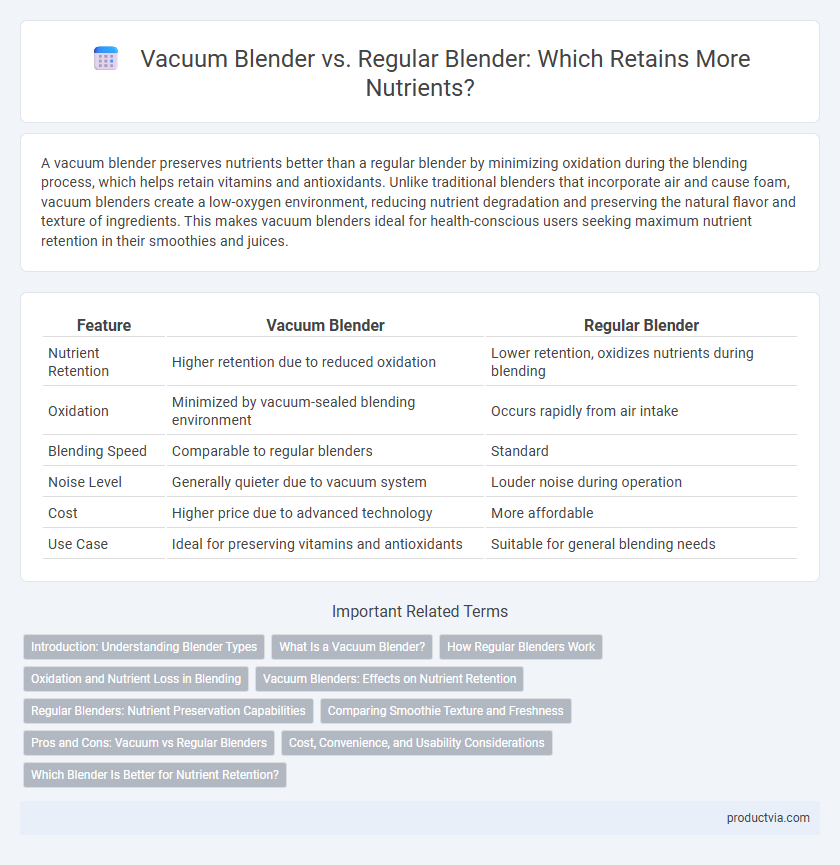A vacuum blender preserves nutrients better than a regular blender by minimizing oxidation during the blending process, which helps retain vitamins and antioxidants. Unlike traditional blenders that incorporate air and cause foam, vacuum blenders create a low-oxygen environment, reducing nutrient degradation and preserving the natural flavor and texture of ingredients. This makes vacuum blenders ideal for health-conscious users seeking maximum nutrient retention in their smoothies and juices.
Table of Comparison
| Feature | Vacuum Blender | Regular Blender |
|---|---|---|
| Nutrient Retention | Higher retention due to reduced oxidation | Lower retention, oxidizes nutrients during blending |
| Oxidation | Minimized by vacuum-sealed blending environment | Occurs rapidly from air intake |
| Blending Speed | Comparable to regular blenders | Standard |
| Noise Level | Generally quieter due to vacuum system | Louder noise during operation |
| Cost | Higher price due to advanced technology | More affordable |
| Use Case | Ideal for preserving vitamins and antioxidants | Suitable for general blending needs |
Introduction: Understanding Blender Types
Vacuum blenders minimize oxidation by removing air before blending, preserving more vitamins and antioxidants compared to regular blenders that introduce air and accelerate nutrient degradation. Studies show vacuum blending retains up to 25% more vitamin C and polyphenols, crucial for maximizing nutrient absorption. Selecting a vacuum blender enhances the freshness and nutritional quality of smoothies and juices.
What Is a Vacuum Blender?
A vacuum blender uses a vacuum pump to remove air from the blending jar before blending, significantly reducing oxidation and nutrient loss in fruits and vegetables. Compared to regular blenders, vacuum blenders preserve higher levels of vitamins, antioxidants, and enzymes by minimizing exposure to oxygen during the blending process. This technology is especially beneficial for maintaining vibrant colors, fresh flavors, and enhanced nutrient retention in smoothies and juices.
How Regular Blenders Work
Regular blenders operate by spinning sharp blades at high speeds, creating turbulence that introduces oxygen into the mixture. This oxidation process can lead to nutrient degradation, especially of sensitive vitamins like vitamin C and antioxidants. As a result, regular blenders may reduce the overall nutrient retention in smoothies compared to vacuum blenders.
Oxidation and Nutrient Loss in Blending
Vacuum blenders reduce oxidation by removing air before blending, preserving higher levels of sensitive nutrients such as vitamins C and E compared to regular blenders. The lower oxygen exposure in vacuum blending slows down enzymatic browning and nutrient degradation, maintaining fresher flavors and better antioxidant profiles. Regular blenders introduce more oxygen, accelerating oxidation and causing significant nutrient loss during the blending process.
Vacuum Blenders: Effects on Nutrient Retention
Vacuum blenders significantly reduce oxidation during blending by removing air before and during the process, which preserves higher levels of vitamins such as vitamin C and antioxidants compared to regular blenders. Studies indicate that vacuum blending retains up to 50% more nutrients, maintaining the freshness and potency of fruits and vegetables in smoothies and juices. This method also helps slow down enzymatic browning and nutrient degradation, making vacuum blenders ideal for nutrient-dense recipes.
Regular Blenders: Nutrient Preservation Capabilities
Regular blenders use high-speed blades that generate heat, which can lead to some nutrient degradation, particularly of heat-sensitive vitamins like vitamin C and certain antioxidants. Despite this, regular blenders efficiently break down fibrous materials, enhancing the bioavailability of nutrients by increasing surface area for digestion. While nutrient retention is not as optimal as vacuum blenders that reduce oxidation, regular blenders remain effective for preserving most macronutrients and minerals during blending.
Comparing Smoothie Texture and Freshness
Vacuum blenders preserve nutrient retention by removing oxygen before blending, reducing oxidation that dulls smoothie freshness and degrades texture. Regular blenders expose ingredients to air, causing faster nutrient loss and less vibrant flavors, resulting in a coarser and more oxidized smoothie. Vacuum blending produces smoother, creamier textures and maintains peak freshness, ideal for nutrient-dense, long-lasting smoothies.
Pros and Cons: Vacuum vs Regular Blenders
Vacuum blenders reduce oxidation by removing air before blending, preserving more nutrients and vibrant colors in fruits and vegetables compared to regular blenders, which often expose ingredients to air, leading to faster nutrient degradation. Pros of vacuum blenders include extended shelf life of blended mixtures and enhanced flavor retention, while cons involve higher cost and more complex maintenance. Regular blenders offer affordability and simplicity but sacrifice some nutrient quality due to air incorporation during blending.
Cost, Convenience, and Usability Considerations
Vacuum blenders enhance nutrient retention by minimizing oxidation, preserving vitamins and antioxidants more effectively than regular blenders. Cost-wise, vacuum blenders typically demand a higher initial investment but offer greater long-term value through improved nutrient preservation and quieter operation. Convenience and usability vary as vacuum blenders often require additional steps for air removal, potentially increasing blending time, while regular blenders provide straightforward, faster use with less maintenance.
Which Blender Is Better for Nutrient Retention?
Vacuum blenders retain more nutrients than regular blenders by removing air before blending, reducing oxidation and preserving vitamins and antioxidants. Studies show vacuum blending maintains higher levels of Vitamin C and enzymes compared to traditional blending methods. For optimal nutrient retention, vacuum blenders are a superior choice in preserving fresh ingredients' nutritional quality.
Vacuum blender vs regular blender for nutrient retention Infographic

 productvia.com
productvia.com